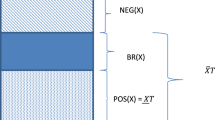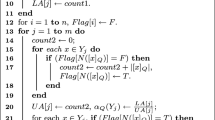Abstract
Detecting outliers which are grossly different from or inconsistent with the remaining spatio-temporal dataset is a major challenge in real-world knowledge discovery and data mining applications. In this paper, we deal with the outlier detection problem in spatio-temporal data and we describe a rough set approach that finds the top outliers in an unlabeled spatio-temporal dataset. The proposed method, called Rough Outlier Set Extraction (ROSE), relies on a rough set theoretic representation of the outlier set using the rough set approximations, i.e. lower and upper approximations. It is also introduced a new set, called Kernel set, a representative subset of the original dataset, significative to outlier detection. Experimental results on real world datasets demonstrate its superiority over results obtained by various clustering algorithms. It is also shown that the kernel set is able to detect the same outliers set but with such less computational time.
Access this chapter
Tax calculation will be finalised at checkout
Purchases are for personal use only
Preview
Unable to display preview. Download preview PDF.
Similar content being viewed by others
References
Bezdek, J.C., Pal, N.R.: Some new indexes for cluster validity. IEEE Trans. Syst., Man, Cybern. B, Cybern. 28(3), 301–315 (1988)
Yao, Y.Y.: Two views of the theory of rough sets in finite universes. International Journal of Approximate Reasoning 15, 291–317 (1996)
Nguyen, T.T.: Outlier Detection: An Approximate Reasoning Approach. Springer, Heidelberg (2007)
Chen, Y., Miao, D., Wang, R.: Outlier Detection Based on Granular Computing. Springer, Heidelberg (2008)
Jiang, F., Sui, Y., Cunge: Outlier Detection Based on Rough Membership Function. Springer, Heidelberg (2006)
Pawlak, Z.: Rough Sets, Theoretical Aspects of Reasoning about data. Kluwer, Dordrecht (1991)
Frentzos, E., Gratsias, K., Pelekis, N., Theodoridis, Y.: Nearest Neighbor Search on Moving Object Trajectories. In: Anshelevich, E., Egenhofer, M.J., Hwang, J. (eds.) SSTD 2005. LNCS, vol. 3633, pp. 328–345. Springer, Heidelberg (2005)
Birant, D., Kut, A.: Spatio-Temporal Outlier Detection in Large Databases. Journal of Computing and Information Technology 14(4), 291–297 (2006)
Maji, P., Pal, S.K.: Rough Set Based Generalized Fuzzy C-Means Algorithm and Quantitative Indices. IEEE Transactions on Systems, Man, and Cybernetics–Part B: Cybernetics 37(6) (December 2007)
Albanese, A., Petrosino, A.: A Non Parametric Approach to the Outlier Detection in Spatio-Temporal Data Analysis. In: D’Atri, et al. (eds.) Springer book Information Technology and Innovation Trends in Organizations (2011)
Author information
Authors and Affiliations
Editor information
Editors and Affiliations
Rights and permissions
Copyright information
© 2011 Springer-Verlag Berlin Heidelberg
About this paper
Cite this paper
Albanese, A., Pal, S.K., Petrosino, A. (2011). A Rough Set Approach to Spatio-temporal Outlier Detection. In: Fanelli, A.M., Pedrycz, W., Petrosino, A. (eds) Fuzzy Logic and Applications. WILF 2011. Lecture Notes in Computer Science(), vol 6857. Springer, Berlin, Heidelberg. https://doi.org/10.1007/978-3-642-23713-3_9
Download citation
DOI: https://doi.org/10.1007/978-3-642-23713-3_9
Publisher Name: Springer, Berlin, Heidelberg
Print ISBN: 978-3-642-23712-6
Online ISBN: 978-3-642-23713-3
eBook Packages: Computer ScienceComputer Science (R0)




